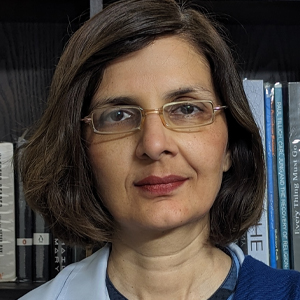Beyond basics in blood
In medical education, vertical integration, or VI, blends basic medical science with clinical practice. A vertically integrated curriculum embeds basic science within clinical settings to ensure students’ knowledge is both theoretical and practical. Students observe common medical procedures and learn necessary precautions, becoming more comfortable and confident in clinical environments as they advance in their studies.
The American Society for Biochemistry and Molecular Biology Student Chapter at Federal Medical College in Islamabad recently designed a vertically integrated module that combined medical biochemistry and immunology with transfusion medicine and public health. Within biochemistry, we integrated the study of lipids, proteins and carbohydrates.
This multifaceted module included large-group interactive sessions, small-group discussions and collaborative learning. We encouraged students to take deep dives into topics and present what they learned through role-playing activities.
A weeklong training at a local blood bank gave students practical insights into complex procedures. We also celebrated World Blood Donation Day, promoting awareness of the importance of giving blood at the community level.
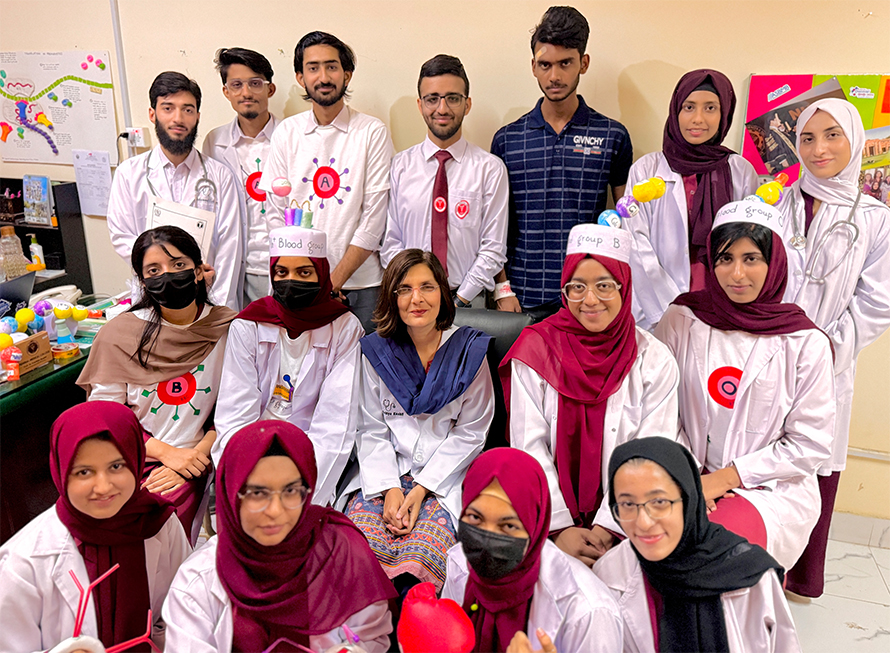
Macromolecular integration
First-year medical students need to understand the structure of macromolecules —carbohydrates, proteins and lipids. However, after a textbook introduction, students often have a hard time visualizing these macromolecules’ interactions and combined functions in real-life scenarios.
To show how they integrate in biological processes, we selected blood group antigens and antibodies as an example of molecular interplay. Complex sugars and lipids are found in the oligosaccharide and lipid components of ABO glycolipids, while the Rh antigen is a transmembrane protein. Through our integrated approach, we showed the collaboration of these proteins, sugars and lipids at the molecular level.
First, the students looked at the structure of cell membranes, with emphasis on how complex oligosaccharides are attached to membrane lipids and proteins, forming the glycocalyx, which is crucial for cellular identity and antigenicity. They then studied the red blood cell membrane structure, especially the composition of blood group antigens, the H antigen, the transferase enzymes involved in antigen construction, and how the addition of a single sugar residue can make one particular type of blood group antigen.
The students then looked at lipids, beginning with the phospholipid and glycolipid composition of cell membranes and then shifting their focus to the glycolipids of ABO antigens. This foundation in sugars and lipids set the stage for learning about proteins.
The students explored the structural hierarchy of proteins from amino acid sequences to complex folding patterns, using membrane proteins as primary examples. They then delved into the complexities of the Rh antigen, a transmembrane protein, investigating its role in antigenicity as well as its role in the maintenance of red blood cell membrane integrity and the transport of ammonia and carbon dioxide.
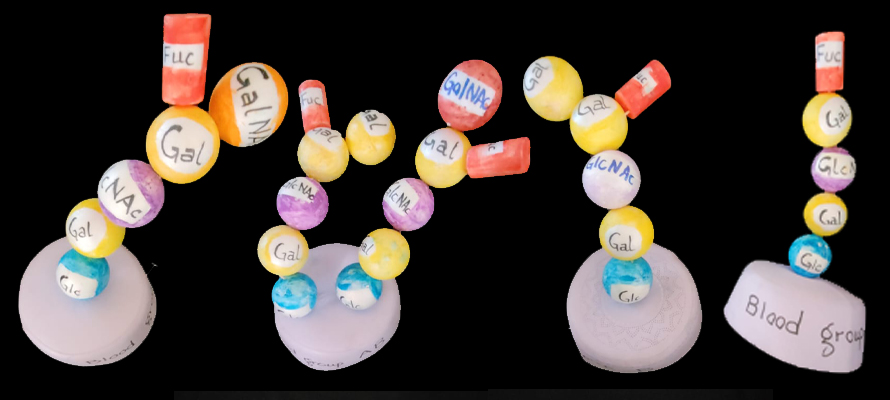
Immunology, role play and transfusion
The students explored the architecture of immunoglobulins as they looked deeper into the intricate world of protein structures. They started with the basic structure of these essential proteins, highlighting their role in the immune system. They then investigated the sophisticated V(D)J recombination process, which generates diverse immunoglobulins. They saw how specific genetic rearrangements create unique antigen-binding sites needed for effective immune responses.
The students also examined the interaction between immunoglobulins and blood group antigens and studied the importance of these interactions in contexts such as blood transfusions and immune responses to pathogens.
Role-playing in medicine often involves simulating doctor and patient roles, but in biochemistry, we modified this approach to focus on cellular interactions. Students assumed the roles of cells and their surface antigens, transforming the classroom into a dynamic interplay of cells and molecules. We crafted costumes by painting T-shirts for each blood type, designed caps to represent cell membranes with protruding antigens, and fashioned bracelets as IgM pentamers to represent antibodies. The students wrote the script and performed the drama.
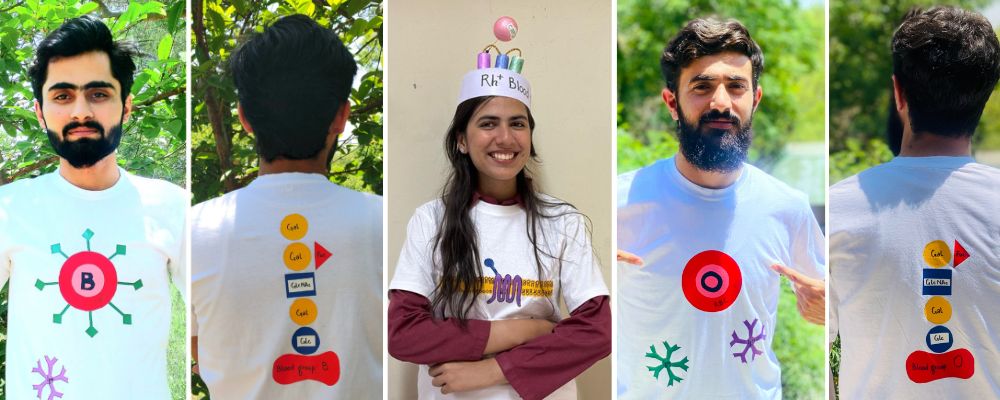
We partnered with the blood bank, where director Farwa Sijjeel delivered a lecture on the clinical intricacies of blood transfusion. She organized and supervised their practical training sessions in the blood bank. The students learned about biochemical processes underlying blood compatibility and transfusion reactions as well as how to address critical issues such as blood component preparation, blood storage and the biochemical basis of transfusion reactions.
We synchronized our activities with World Blood Donation Day. Rabia Mehmood, head of the department of community medicine at our college, provided insights into the public health dimensions of blood transfusion, explaining how understanding biochemical processes underpins effective health care practices. She encouraged the students to create awareness posters and organize a walk in conjunction with the event.
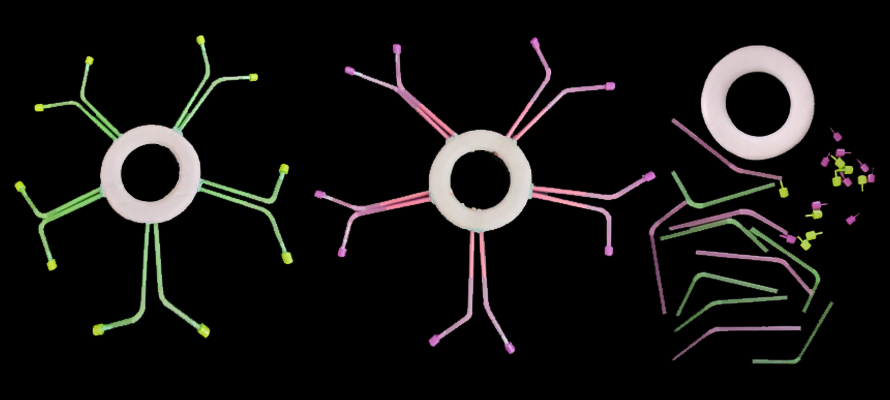
Success and feedback
At the end of the module, we obtained student feedback through Google Forms. Students praised this project, saying that its engaging and informative approach enhanced their understanding of biochemistry and related topics. Many said they appreciated the setup, acting and overall experience and were eager to participate in future activities.
The students said they particularly valued the practical aspects, such as the hands-on training at the blood bank, for providing real-world insights into clinical practices and patient care. They also highlighted the benefits of teamwork, leadership and collaboration gained through the roles they played. They commended the innovative teaching approach and noted that this project not only clarified complex concepts but also inspired them to love biochemistry.
Suggestions for improvement included better teamwork, more inclusive participation and enhanced time management, along with a call for more frequent interdisciplinary seminars and workshops.
Enjoy reading ASBMB Today?
Become a member to receive the print edition four times a year and the digital edition monthly.
Learn moreGet the latest from ASBMB Today
Enter your email address, and we’ll send you a weekly email with recent articles, interviews and more.
Latest in Opinions
Opinions highlights or most popular articles

Debugging my code and teaching with ChatGPT
AI tools like ChatGPT have changed the way an assistant professor teaches and does research. But, he asserts that real growth still comes from struggle, and educators must help students use AI wisely — as scaffolds, not shortcuts.

AI in the lab: The power of smarter questions
An assistant professor discusses AI's evolution from a buzzword to a trusted research partner. It helps streamline reviews, troubleshoot code, save time and spark ideas, but its success relies on combining AI with expertise and critical thinking.

How AlphaFold transformed my classroom into a research lab
A high school science teacher reflects on how AI-integrated technologies help her students ponder realistic research questions with hands-on learning.

Writing with AI turns chaos into clarity
Associate professor shares how generative AI, used as a creative whiteboard, helps scientists refine ideas, structure complexity and sharpen clarity — transforming the messy process of discovery into compelling science writing.

Teaching AI to listen
A computational medicine graduate student reflects on building natural language processing tools that extract meaning from messy clinical notes — transforming how we identify genetic risk while redefining what it means to listen in science.

What’s in a diagnosis?
When Jessica Foglio’s son Ben was first diagnosed with cerebral palsy, the label didn’t feel right. Whole exome sequencing revealed a rare disorder called Salla disease. Now Jessica is building community and driving research for answers.

